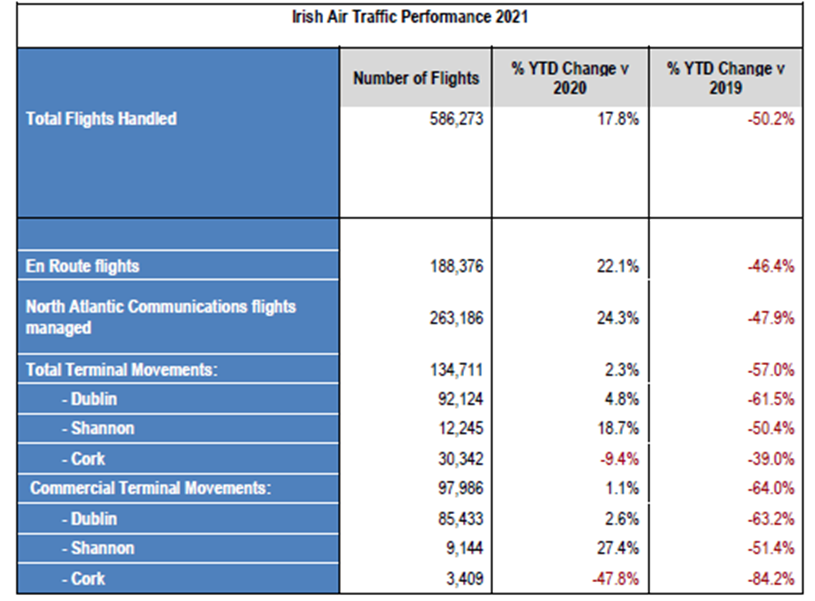2022 can be year of sustainable recovery for Irish Aviation
- 2021 air traffic levels remained 50% below 2019 levels but improved on 2020
- Positive strong forward bookings for 2022 gives aviation sector hope
- Aviation industry resilient with priority to rebuild Irish connectivity in 2022
The Irish Aviation Authority Air Navigation Services Provider (IAA ANSP) has confirmed today that 2021 was a further difficult year for the aviation sector in Ireland, with air traffic levels only marginally higher than 2020. However, there is industry wide optimism for a much improved 2022 and significant demand amongst passengers to travel this year.
Figures produced by the IAA ANSP today show there were 586,273 flights managed in Irish controlled airspace last year, compared to 497,648 in 2020 (a 17% increase). However, the overall level of activity for 2021 was 50% lower than those reported for 2019, before the outbreak of COVID-19, when 1,176,490 flights were safely managed by the IAA ANSP.
Mr Peter Kearney, Chief Executive of the IAA said,
“These figures emphasise just how difficult the past two years have been for the aviation industry in Ireland. As well as the impact on jobs and businesses, these figures reflect the loss in connectivity that the pandemic has caused. As an island nation, with an export driven economy, we rely heavily on aviation as a key enabler of economic and social prosperity. It must be a priority for the aviation sector, for business and for Government to re-build this lost connectivity in 2022.”
Air traffic during January-June 2021 was 62% lower than the equivalent period in 2019. This represents the worst half-year reduction for flight numbers in Irish airspace since records began.
Following the lifting of restrictions on 19th July 2021 air traffic slowly increased in the second half of the year, however flights between July-December remained 38% lower than 2019. There were 12,972 flights during December 2021. This represents 259% increase on December 2020 but still a decrease of 23% compared to December 2019.
Mr Peter Kearney, continued,
“The implementation of harmonised rules across Europe through the Digital COVID Certificate (DCC) has been a vitally important factor in re-starting the industry from July last year. There has been gradual and steady growth as the public’s confidence to travel again has been restored and we are now at a critical milestone in this recovery. There is strong demand for travel in summer 2022. Certainty for passengers around the use of DCCs, and no increase in restrictions will be important in ensuring that 2022 can be a year of recovery for aviation.”
The 2021 figures indicate that while recovery is happening, it is somewhat uneven. While En-route flights (flights which do not land in Ireland) were -46.4% of 2019 levels, total commercial flights at the State airports remained much lower. Dublin Airport recorded 63.2% less arrivals and departures in 2021 compared to 2019, with 51.4% less movements at Shannon Airport. The closure of the main runway at Cork Airport for 10 weeks between September and November affected recovery at Cork, with 84.2% less flights in 2021 compared to 2019.
Mr. Kearney concluded,
These figures indicate the scale of the task ahead to restore Irish aviation to its position pre-pandemic as a global leader. However, I am optimistic for 2022 and while we are unlikely to fully recover to 2019 levels, a strong year is expected. Particular focus must be given to regrowth of connectivity on transatlantic routes and at regional airports, in order to ensure a balanced recovery. We remain conscious of the risks of further COVID-19 variants, but aviation has shown its resilience and adaptability over the past two years. The IAA ANSP is committed to safely managing a sustainable recovery for aviation in the interests of passengers.
The table below summarises air traffic levels in Irish airspace in 2021.




